Tamron 28-300 3.5-6.3 XR Di VC LD
v
Canon 24-105 f4 L and other Canon "L" and Prime Lenses
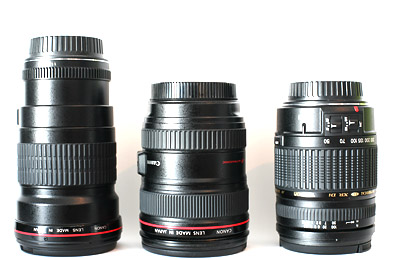
Part I - Conclusion
This test turned out differently from my expectations.
I understand that the 28-300 XR Di VC LD (as it is snappily named) was Tamron's first image stabilised lens. So I was expecting the big story to be whether the "VC" worked, and how it compared with Canon's "IS". As a long time user and fan of superzooms and defender of "third party" lenses I was expecting the other stories to be how much better a superzoom is than people expect, and how little difference there is between a Tamron lens and a top-of-the-range Canon "L" lens.
I spent a lot of time testing the Tamron 20-300 VC, and I learnt a lot. The things I learnt were not those I was testing for, but they were useful lessons nonetheless. Sadly my extensive optical tests are hardly worth sharing, as they cannot affect the "executive summary" conclusion which is that you should not buy this lens (in Canon mount, at least). Nevertheless I will record them here for what they're worth. More important, I think, are my experiences with compatibility and with Tamron's customer service, such that it is.
Why Canon users should not buy the Tamron 28-300 VC
There are two current Canon DSLRs for which this lens may be appropriate; the EOS 5D and the EOS 1Ds Mark III. These are the only current "full frame" Canon DSLR cameras and therefore match the image circle from this lens. For users of Canon "EF-s" mount DSLRs and the older "crop" cameras such as the EOS 10D and its predecessors, Tamron's AF18-270mm F3.5-6.3 Di II VC is the appropriate lens, being designed (as indicated by the DI-II designation) for the smaller sensors.
The Tamron website has this to say about compatibility:
-
If the 28-300mm Di VC (model A20) for Canon is used with EOS-1Ds, the Vibration Compensation Mechanism will not function properly.
-
When 28-300mm Di VC (model A20) is used in Combination with some of the EOS Series (film camera), the VC function may not work.
*EOS-Rebel Ts (300X, Kiss7), Rebel K2 (3000V, Kiss Lite), 100QD, 10QD, 850, 750QD, 650, 620, 630 (630QD, 600)
Assuming the reference to EOS 1Ds includes the latest Mark III, that narrows down the appropriate current cameras on which to mount this lens to one - the EOS 5D. It also implies it should work on all film cameras other than those listed.
In fact my experience was that the 28-300VC was not properly compatible with my EOS 5D, and was completely incompatible (not just the VC) with my EOS 100 film camera. The problem on the 5D was quite subtle, and my first set of tests, although extensive, did not pick it up. More worrying than the incompatibility, however, was that Tamron's UK agents, Intro2020, did not respond to any of my emails. When I returned the lens and phoned them, they told me they did not possess a Canon EOS 5D so they would test my lens on an EOS 40D! So, the Tamron lens does not appear to be compatible with either of the current full-frame Canon DSLRs, and it is a poor match for the crop-sensor DSLRs. It does not appear to work at all with a large range of film cameras including ones not identified by Tamron's official compatibility information. That leaves approximately nobody as potential purchasers for the Canon mount version of this lens.
Incompatibility with (my) EOS 5D and EOS 100
To cut a long story short(ish), the 28-300 VC did not focus properly at infinity with my EOS 5D. But it did not work at all with my EOS 100 film camera. If I had an EOS 100QD, I could have legitimately expected from the compatibility warning above that the lens would work but without the VC function. Despite not being specifically listed as incompatible, not only did the VC not work on the EOS 100 (switching it on simply had no effect) but irrespective of whether VC was switched on or not the camera simply "crashed" after about 30 seconds of use with the lens and could only be brought back to life by removing the battery and putting a Canon lens on the mount. The same camera works perfectly (including "IS") with the Canon 24-105 f4 L.
With the EOS 5D, between about 28 to 50mm, the lens would not focus on infinity. All other focal lengths and focus distances were fine, although slow and noisy compared with the 24-105L. Normally when a lens cannot find focus it "hunts" and if the camera is set for focus priority (as is the default) it will not take a photo until it has "locked" onto focus. Oddly, the Tamron lens would hunt but still allow a photo to be taken. At first I thought it was just a case of normal focus hunting due to low contrast and it being quite a slow lens. But further testing showed that even highly contrasty subjects in brilliant sunlight did not make any difference. Below are two example shots of tower bridge, the top one with autofocus and the second manual. I should add that I could only just see the lack of focus through the viewfinder, and it is not something which would be obvious to all users.
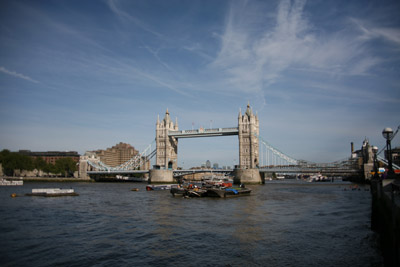
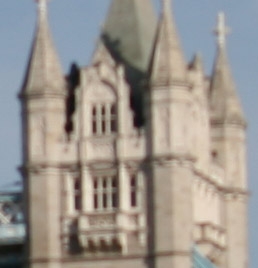
Above: Tamron 28-300 VR, 28mm, 1/3200s f3.5, ISO 100, autofocus
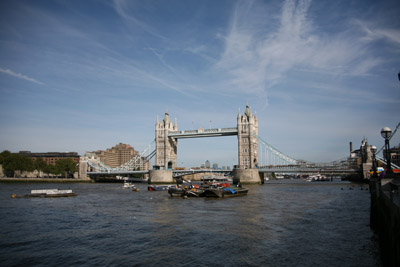
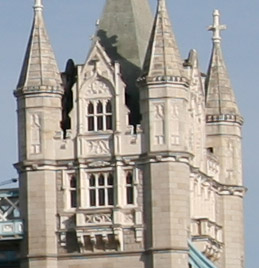
Above: Tamron 28-300 VR, 28mm, 1/3200s f3.5, ISO 100, manual focus
The Tamron (and UK Optics) Customer Service Experience
I bought the 28-300VR new from UK Optics for £399, a whole £100 cheaper than Jessops. I shouldn't have done that. I returned it "as new" in all its original packaging 30 days after it was delivered to me. Two and a half months, 31 emails, four phone calls and one threat of legal action later, I got a refund of £399, leaving me out of pocket only for the original cost of delivery and the cost of returning the lens to them. Now that's what you call customer service!
I can forward the full email chain to anyone masochistic enough to want to read it, but I have extracted some highlights which should give a flavour of my experience below. I never received any response whatsoever from Info 2020, Tamron's UK representative, who I sent various emails. When I telephoned them they told me UK Optics were talking nonsense about there being a £40+ cost for returning a lens which was "within specifications." They also rather disturbingly told me they did not have access to an EOS 5D for testing purposes!
"...As we cannot find a specific fault, and feel the lens is within
specifiaction we are relectant to send it for repair as they [Tamron] will charge for
No Fault Found.
If you feel strongly that you would like us to send it for repair, and agree
to pay for any charges the Repair Centre may caharge for No Fault Found, or
repir or work outside of warranty then we would return to the repair centre
on that basis.
Please let us know what you would prefer,
as we would like to move the situation forward..." (UK Optics, 6 October 2008)***
"...I have tested the lens again with a Canon 450D and a 400D, and the lens
appears to behave and operate normally...
...We are reluctant to send to Tamron, as we believe they will not find a fault
and charge - which I imagine would be in the region of £40 +.
We have both looked independently and thoroughly at your lens, and tested in
different conditions over different days, and desipte resonable efforts have
not found fault, and not sure on the best way forward, as you are obviously
not 100% happy with the lens, we donít want to be in the position of sending
for repair, and having or presenting a bill for NFF, and delays in comparing
with another lens due to stock issues with the supplier which is outside our
control..." (UK Optics, 7 October 2008)***
"...As the Service Centre previously confirmed to you, and Im sure you informed
myself after communication with them in an earlier email or phone call They
did not have a 5D.
The fact remains there is no fault found with the Lens as tested by Tamrons
Engineers (and the lens is operating within normal specification) at this
time..." (UK Optics, 14 November 2008)***
"Tamron state the lens is compatable with the 5D, and the engineers connot
find fault.
Like we advised we can only go by the professional engineers findings.
As there is no fault found, there will be £25 charge to return the lens to
yourself.
However it appears that obviously you will not be happy with the lens with
your 5D, So we are prepared to offer the following which we feel is very reasonable
under the circumstances.
We are prepared to keep/re-buy the lens ourselves and offer you a refund for
£374.00 (the product price of £399 less £25.00) for the lens (being found
NOT to be Faulty by the Engineers) as a goodwill gesture to finally resolve
this matter.
Please confirm if you are agreeable by return, as we will withdraw the offer after 7 days." (UK Optics 17 November 2008)***
One (serious) threat of legal action later...
"To resolve the matter we will will refund you £399 as you request as it is
not worth further time on this matter." (UK Optics 27 November 2008)
Was it just my lens/camera?Sadly, despite the protracted returns process, I have no idea whether the lens I had was representative of others, or even whether the same lens would have worked on other 5Ds. Mine is one of the earliest 5Ds which suffered from a number of "teething" problems, including requiring its entire motherboard to be replaced (which Canon did for free) in order to upgrade to the latest firmware. However as Tamron's official UK agent does not even have access to a 5D, and felt it perfectly acceptable to "test" the lens on a different camera in order to report a full bill of health, I have lost all confidence in them as an organisation. Even if other lens/camera combinations do work, who is to say the lens will still work when you upgrade to a 5D Mark II or other future camera?
Part 2 - Summary of optical tests - Why the conclusion is a shame